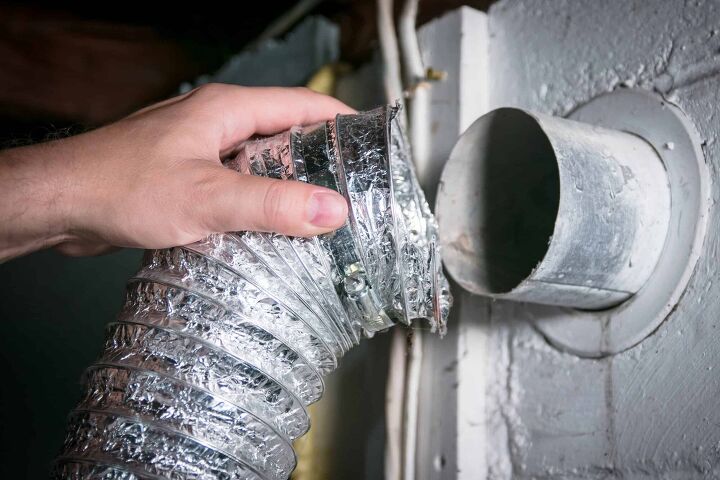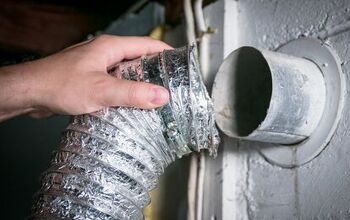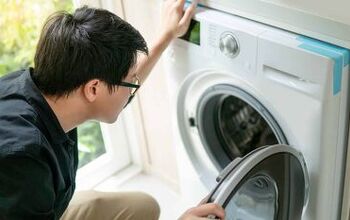How To Vent A Dryer In The Middle Of The House

No matter where your dryer is located, venting it is just as important as setting the dryer up itself. A dryer’s vent directs moisture and heat away from the dryer and out of the house. If you install a dryer without a vent, you run the risk of moisture building up, leading to mold, mildew, and water damage.
To install a vent dryer in the middle of the house, you need to vent it downwards so that the air and moisture are going through the floor and out. Since you don’t have the convenience of putting the dryer against an exterior wall, you’ll need to angle a periscope dryer vent so that it is pointing down at a 90-degree angle.
Underneath the floor, you’ll need to install another periscope dryer vent facing the opposite direction as the one above-head connected to the dryer. Seal the periscope vent using a spray foam sealant, and your new venting set up should hold and keep moisture and hot air out.
Unfortunately, if you do not have a basement or crawlspace beneath where you plan on placing the dryer if it is in the middle of the house, you won’t be able to do this. Let’s explore how to vent a dryer in the middle of the house more closely. In this article, we will explain precisely how to vent your dryer in the middle of your home.
Do You Need Ducts or Vents Installation or Replacement?
Get free, zero-commitment quotes from pro contractors near you.

Is It Safe To Vent A Dryer In The Middle Of The House?
While not as safe as venting a dryer using an exterior wall, venting a dryer in the middle of the house is safe if precautions are taken. If you need to vent a dryer in the middle of the house, the issue of lint becomes more of a problem than when using an exterior wall.
That is because lint is flammable. When a dryer is vented outside is vented outside, lint freely blows and effectively gets “out of the way.” While venting a dryer in the middle of the house, however, you won’t have the luxury of venting outside in every case. Instead, your best option is venting downward to the basement.
Things You Can Do To Ensure Your Safety
There are a few things you can do to ensure safety when venting a dryer in the middle of the house, such as:
- Make sure both ends of the dryer vent are unobstructed
- Clean the venting tube to get rid of excess lint
- Place container of water at the output end of the vent
- Use flexible vent pipes
Keep in mind that venting in the middle of the house increases the risk of mold and mildew inside. That is because the moisture has nowhere to escape; it simply diffuses into the air. If possible, vent the dryer downwards into an open space that has airflow to reduce the risk of mold.
What Materials Do You Need?
You will need to gather a handful of materials before you can vent your dryer in the middle of the house, including:
- Two dryer venting hookup periscopes ($20-$30 each)
- A spray foam insulation ($3.50-$8.00)
- PVC pipe ($3.00-$7.00)
If your house has a half-basement, you are in luck. In that case, you can use the PVC to further vent the heat and moisture leading out of the house. Many half-basement homes have openings for the purpose of venting, and if yours does, run the PVC from the second periscope to the outside, and it will be perfect.
Let’s get into the steps that you need to follow to vent a dryer in the middle of the house.
Video: Installing Dryer Vent In Middle of House
Step 1: Place The First Venting Hookup
Put the first venting periscope through the floor over an existing vent if possible. Otherwise, cuts will need to be made. Place the periscope so that it is at as much of a 90-degree angle as possible. Line it up with the dryer and connect the back of it to the periscope to make sure that it fits.
If it doesn’t fit, then you will need to go to the store and purchase one that does. Or, you can get a clamp if the connector is too small. The circle clamp will go around the contraption, and then you can simply tighten it around without cutting off the flow. This will help to keep everything in place.
Step 2: Install The Second Periscope
Head downstairs and look to make sure that the first periscope is hanging correctly. Now, take the second periscope and attach them together by connecting the top open end of the second one to the open bottom end of the first one that is connected to the dryer.
When you are done, the second periscope’s bottom opening should be facing the opposite direction as the top one connected to the dryer upstairs.
Step 3: Seal And Insulate
You could use a silicone sealant, but your best bet is to seal the periscope downstairs using spray foam insulation. That will come in handy when the dryer is running to minimize airflow and lint particles in the air. Be careful not to blow the airflow with the sealant, though. You want to apply it on the outside, not the inside of the vent.
Step 4: Run PVC
This step depends entirely on your house’s layout. Let’s split this step into two alternate parts: A and B.
PVC Connection A
For the A scenario, let’s assume that you have a half-basement or basement with space for you to run PVC leading outdoors. If you do, that is great because it will minimize chances for mold and overheating.
Measure the opening of the periscope. Often, all that you will need is 4”-6” PVC to make the connection. Connect the PVC and run it all the way to the opening leading outside. Allow for 5”-8” of overlap outside to make sure the heat is going out properly.
For good measure, attach a mesh or flap to the end of the PVC pipe to help keep unwanted bugs from entering the pipe.
PVC Connection B
The B scenario refers to your basement not having access to outside venting. In that case, you should still attach PVC, but you won’t be running it outdoors.
4”-6” PVC piping will still do the trick. What you should do is position the PVC hanging off of the open bottom end of the periscope so that it is angled down.
If you have room for it, consider leaving an open container of water beneath the PVC. That way, if and when excess lint makes its way through the venting, it will land in the water. By doing this, you will reduce the fire risk associated with venting your dryer indoors.
Should I Hire A Professional?
Hiring a professional is always an option and a smart decision if you aren’t sure what you’re doing. If you’re unsure whether you can do this project or not, it might be a better idea to seek professional advice or assistance.
Related Questions
How long should a dryer vent in the middle of the house be?
Your dryer vent should be no longer than 35 feet in length. This is because anything longer will not be efficient in venting the gases out of your home. It will most likely come back in through the dryer or other areas within the home, depending on what the vent is hooked to or through.
Can you clean dryer vents to keep them in good shape?
Yes, you can clean dryer vents to keep them in good shape. Inspect your dryer once or twice a year, or more if there are performance problems. Generally, venting issues are caused by buildups of lent. Remove the excess lent by using a prod or long object to carefully push it out.
How much does it cost to vent a dryer in the middle of the house?
It costs between $70 and $200 to vent a dryer in the middle of the house. The cost is mostly determined by the materials that you choose. However, if you’re hiring someone to do this job, you can expect to pay even more. To hire a professional for this job, you can expect to pay anywhere from $150 to $500, depending on the contractor or company that you go through.
Do You Need Ducts or Vents Installation or Replacement?
Get free, zero-commitment quotes from pro contractors near you.

Summing It Up
Venting a dryer in the middle of the house is not always ideal, but it is possible. Some people don’t choose, as the ‘laundry room’ is in a middle hallway closet, tucked away from the exterior wall. When venting your dryer, make sure that you use two dryer vent periscopes. Sealing the periscope that is beneath the floor is vital so that there is no air leaking.
Once your dryer is vented in the middle of the house, follow up by inspecting it once or twice a year to get rid of lint buildups. It also wouldn’t hurt to put a container of water at the end of the length of PVC for fire safety. As always, if you’re not comfortable doing this yourself, you can always hire a professional to do the whole job, or at least assist you.
Related Guides

Nick Durante is a professional writer with a primary focus on home improvement. When he is not writing about home improvement or taking on projects around the house, he likes to read and create art. He is always looking towards the newest trends in home improvement.
More by Nick Durante














![The 10 Best Table Saws - [2022 Reviews & Buyer's Guide]](https://cdn-fastly.upgradedhome.com/media/2023/07/31/9070645/the-10-best-table-saws-2022-reviews-buyer-s-guide.jpg?size=350x220)












